The Citizens Coinage Advisory Committee (CCAC) and Commission of Fine Arts (CFA) have recommended designs for the U.S. Mint’s 2019-dated America the Beautiful Quarters® and companion 5-ounce silver coins.
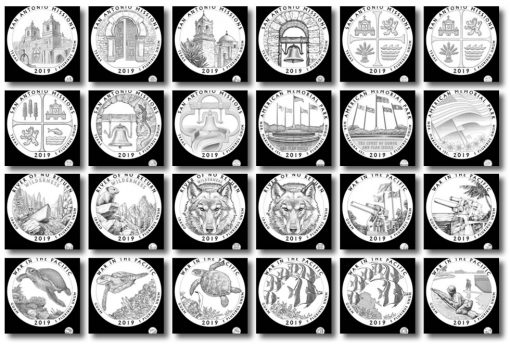
Introduced in 2010, the 56-quarter series celebrates national sites throughout the 50 states, the District of Columbia and the five U.S. territories. The five locations up for honors in 2019 are:
- Lowell National Historical Park in Massachusetts,
- American Memorial Park in Northern Mariana Islands,
- War in the Pacific National Historical Park in Guam,
- San Antonio Missions National Historical Park in Texas, and
- Frank Church River of No Return Wilderness in Idaho.
Overall, 75 proposed design were submitted for review. The CCAC looked them over on Sept. 19 and the CFA appraised them on Sept. 20.
Below are U.S. Mint images and descriptions of candidate designs for the five sites. Liaison, CFA and CCAC recommendations are provided immediately below the site titles.
Lowell National Historical Park (Massachusetts)
Eighteen designs for the Massachusetts quarter were reviewed. The park’s liaison preferred design #4.
CCAC Recommendations: Members selected design #11, subject to changing the direction of the wheel’s scoops.
CFA Recommendations: Members preferred design #16.
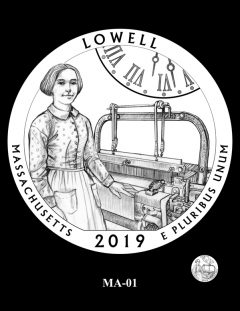 |
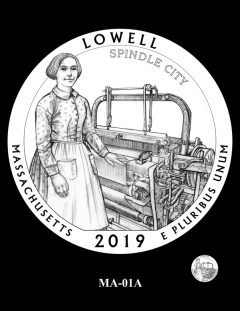 |
MA-01 depicts a mid-19th century mill girl standing in front of a power loom. She holds the shuttle used in the weaving process. Behind her is the town clock, symbolic of the regimented work day of the girls.
MA-01A shows a mill girl standing in front of a power loom from the period. The inscription "SPINDLE CITY," a common nickname for textile towns, is across the top of the design.
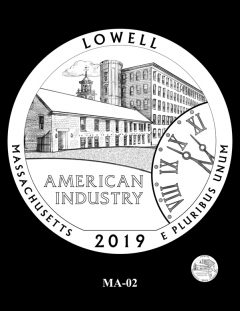 |
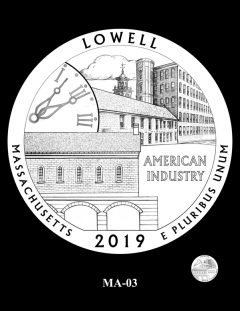 |
MA-02 features the Boott Cotton Mills complex in Lowell, containing mills built from the mid-1830s to the early 1900s. The clocktower is seen in the background, governing the work day. The inscription "AMERICAN INDUSTRY" is at the bottom of the design.
MA-03 depicts three critical components of the manufacturing environment at Lowell: water power (represented by the Moody Street Feeder Gate), a structured work force (represented by the clock face), and the ability to mass produce goods, which is depicted by the large-scale factory buildings. The inscription "AMERICAN INDUSTRY" is also included.
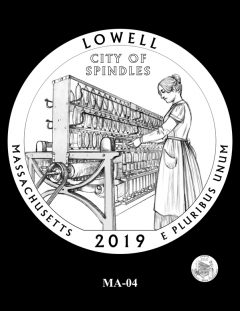 |
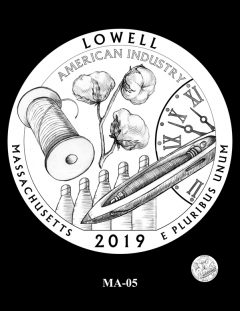 |
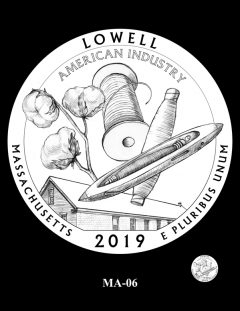 |
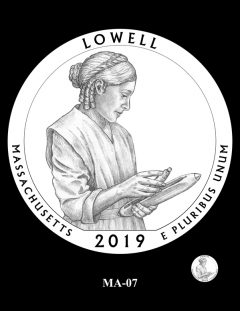 |
MA-04 features a young mill girl tending her ring spinning machine in a Lowell mill. The inscription "CITY OF SPINDLES" is included across the top. This park’s liaison preferred this design.
MA-05 illustrates the elements of the textile process from farm to factory: raw cotton, shuttles, bobbins, and the ever-present town clock. The inscription "AMERICAN INDUSTRY" is at the top of the design.
MA-06 showcases the simple items that define the textile process – from raw cotton for spinning to the power looms and the large-scale manufacturing buildings found in Lowell. The inscription "AMERICAN INDUSTRY" is included.
MA-07 depicts a young mill girl placing a threaded bobbin into a weaving loom boat shuttle.
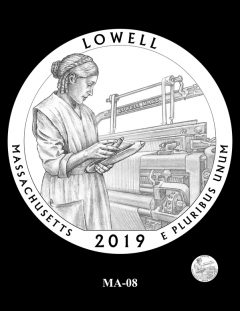 |
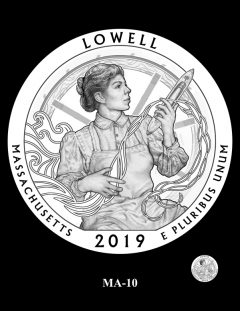 |
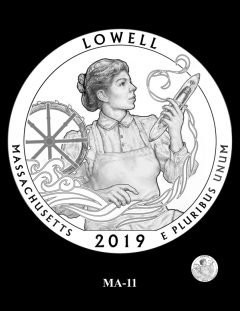 |
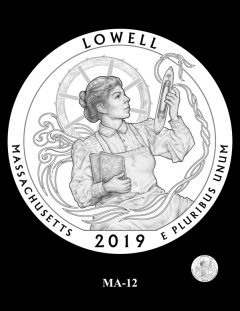 |
MA-08 features a young mill girl on the factory floor placing a threaded bobbin into a weaving loom boat shuttle as she prepares to set the loom in motion.
MA-10, MA-11 (the CCAC’s preference), and MA-12 depict a mill girl spinning thread that is stylized to look like water, indicating the importance of the of the canal system in powering the mills throughout the factories of Lowell. A water wheel is in the background.
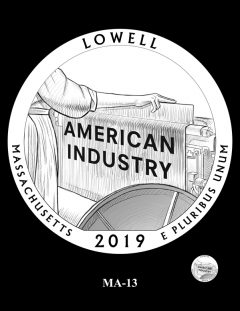 |
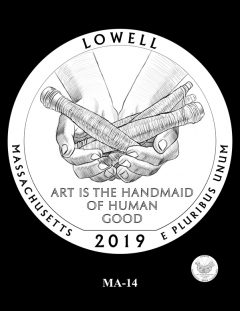 |
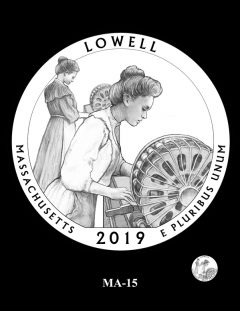 |
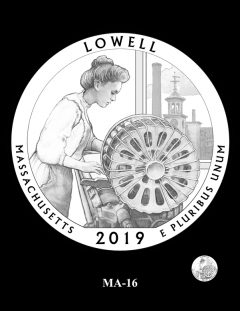 |
MA-13 features one of the mill girls working at her machine. The phrase, "AMERICAN INDUSTRY" is incused into the plane of thread.
MA-14 depicts a mill girl’s hands holding a group of spindles, representing the work done within the mills. The city motto, "ART IS THE HANDMAID OF HUMAN GOOD," is inscribed at the bottom to represent the importance and benefits of industry and innovation.
MA-15 depicts mill girls working at bobbin battery machines.
MA-16 depicts a mill girl working at a bobbin battery machine with a view of Lowell, including the clocktower, through the window. The CFA preferred this design.
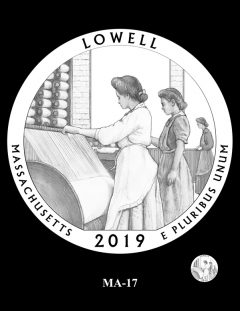 |
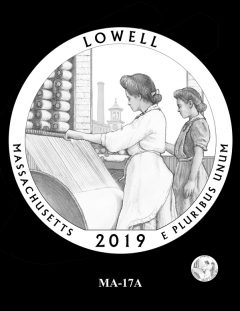 |
MA-17 depicts mill girls working with warping threads in the Boott Cotton Mills factory.
Design MA-17A includes the familiar clock tower through the window.
American Memorial Park (Northern Mariana Islands)
Ten designs for the Northern Mariana Islands quarter were reviewed. The park’s liaison, the CFA and the CCAC preferred design #1. The CCAC did ask for some variations to the design that could be reviewed later with discussions mostly surrounding the layout of the flags and how they appear more realistic in design #2..
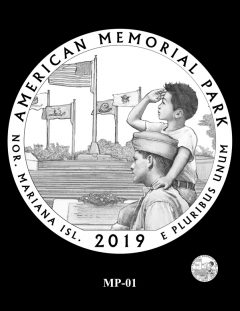 |
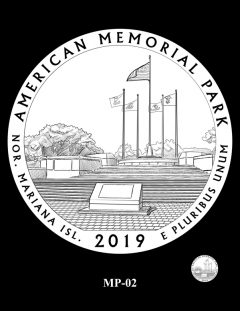 |
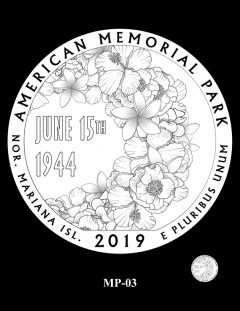 |
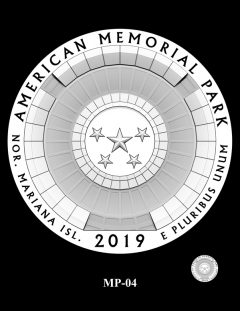 |
MP-01 features a Chamorro boy saluting the American flag while on the shoulder of a soldier at the Memorial Court of Honor and Flag Circle. The memorial honors the sacrifice made by those who lost their lives in the Marianas Campaign during World War II.
MP-02 depicts the Memorial Court of Honor and Flag Circle, one of the main features of the park.
MP-03 depicts part of a floral wreath, honoring those who lost their lives in battle. The date, "JUNE 15, 1944," marks the day American forces arrived on Saipan.
MP-04 is an abstract depiction of the Memorial Court of Honor and Flag Circle viewed from above. The stars in the middle represent the American flag as well as the flags of the military branches that took part in the Marianas Campaign.
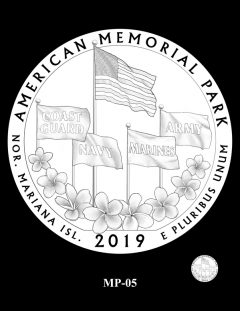 |
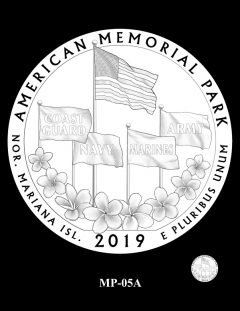 |
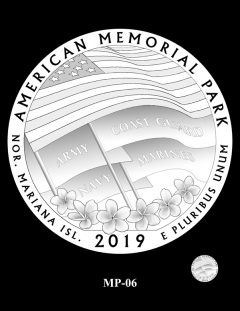 |
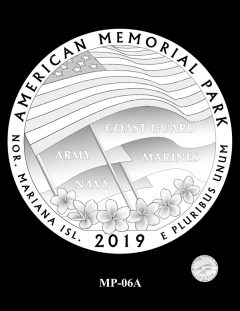 |
MP-05, MP-05A, MP-06, and MP-06A all feature representations of the flags from the Flag Circle, paired with plumeria, the official flower of the Commonwealth of Northern Mariana Islands. The plumeria blossoms pay tribute to the many residents of the island who lost their lives during the battle. The names of the branches are inscribed on the flags.
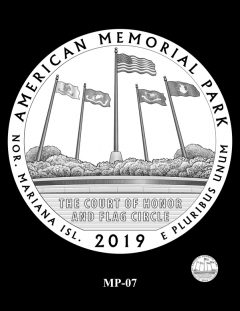 |
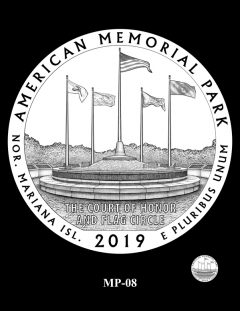 |
MP-07 portrays a perspective of the Court of Honor and Flag Circle from just below the steps that lead up to the base of the memorial.
MP-08 showcases the Court of Honor and Flag Circle from an elevation view, or eye level, when one is standing on the landing at the base of the memorial.
War in the Pacific National Historical Park (Guam)
Ten designs for the Guam quarter were reviewed.
CCAC Recommendations: Members selected design #3.
CFA Recommendations: Members liked design #2, which was also preferred by the park’s liaison.
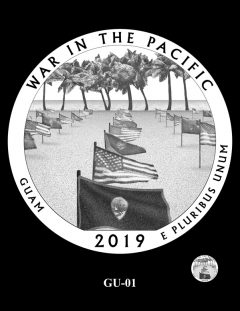 |
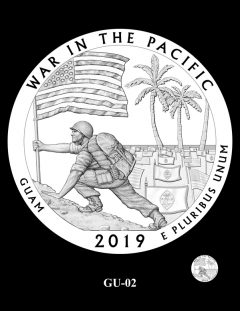 |
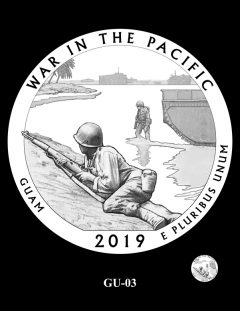 |
|
GU-01 features the island’s Memorial Day Flag display, where each year volunteers place flags from both the U.S. and Guam — with tea lights at night — on Asan Beach. The annual display is done in remembrance and honor of those who lost their lives during the battle.
GU-02 juxtaposes a U.S. Marine planting the American flag into the sands of Guam on the day the American Forces arrived with the present-day Memorial Day Flag display at Asan Beach.
GU-03 portrays a wave of American Forces coming ashore at Asan Bay, strengthening the number of troops on the island in the fight for the island of Guam and its eventual liberation.
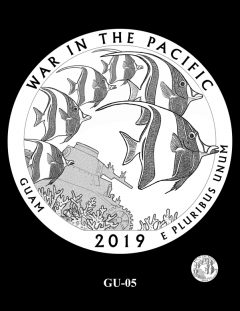 |
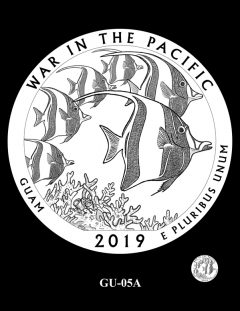 |
GU-05 and GU-05A depict Moorish Idol fish swimming among the coral reef. Design 05 also features remnants of the war as the rich Pacific Ocean transforms them into something new.
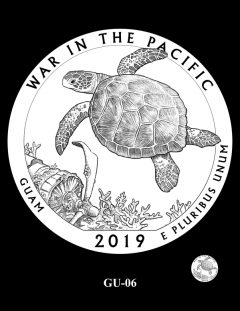 |
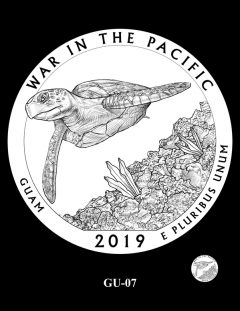 |
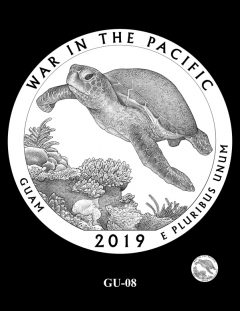 |
|
GU-06 portrays an endangered Green Sea Turtle, as the coral reef transforms artifacts from the Marianas Campaign for its own use.
GU-07 and GU-08 emphasize the biodiversity of the park as an endangered mature Green Sea Turtle swims over a coral reef off Asan Beach, representing the park’s efforts to preserve and protect the fragile ecosystem.
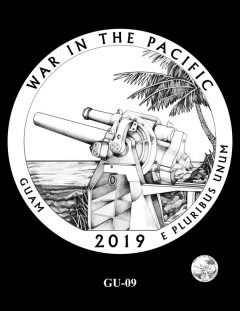 |
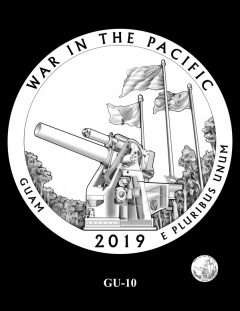 |
GU-09 and GU-10 depict a memorial at Ga’an Point, featuring a Japanese cannon. Design 10 also includes the flags of the United States, Guam, and Japan.
San Antonio Missions National Historical Park (Texas)
Fifteen designs for the Texas quarter were reviewed. Designs #3, 3a and 3b were preferred by the park’s liaison.
CCAC Recommendations: Members selected design #3b.
CFA Recommendations: Members also preferred design #3b, but with the waves on the coin modified to look more like water.
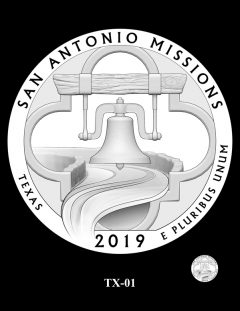 |
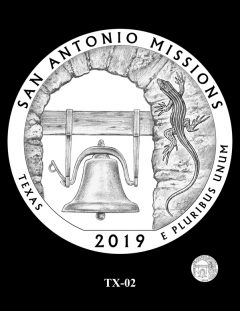 |
TX-01 represents the park through its most iconic components: Water flowing through an acequia, an iron mission bell and the architectural element of a quatrefoil. Additionally the semicircular arcs represent the arched bell towers common to the park.
TX-02 portrays a Mission bell housed in a stone archway while a Texas Spotted Whiptail lizard, common to the park, climbs the stonework.
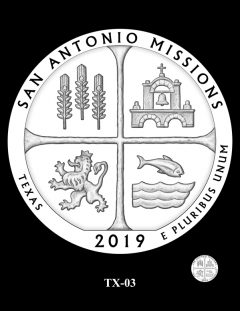 |
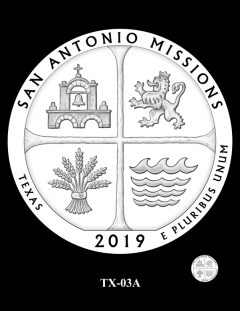 |
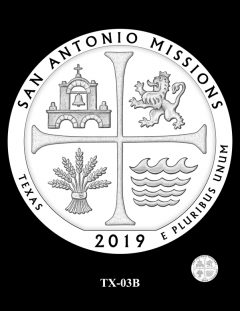 |
|
TX-03, TX-03A and TX-03B use elements of the Spanish Colonial Reale coin, in its iconography and composition of four quadrants, to pay tribute to the missions. Within the quadrants are symbols of the missions. Wheat symbolizes farming and cultivation of the mission lands. The arches and a bell tower symbolize fortress, community and home. A Heraldic Lion represents Spanish cultural heritage. A symbol of the San Antonio River represents irrigation methods and life-sustaining resources harnessed by the missions.
TX-04 depicts a bell in a stone archway.
TX-05 presents the facade of Mission San José.
TX-06 focuses on the front doors of Mission Concepción. One door is ajar inviting the viewer to come in.
TX-07 depicts the facade of Mission Concepción.
TX-08 showcases the details of the facade of Mission Espada.
TX-09 highlights the details of the "Rose Window" of Mission San José.
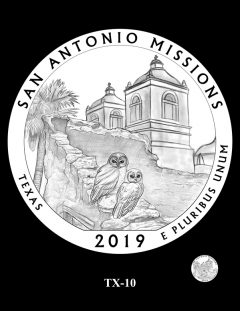 |
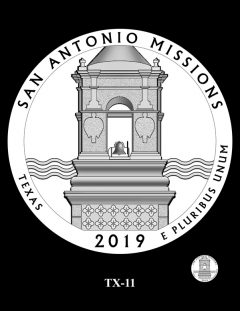 |
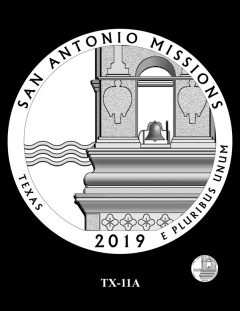 |
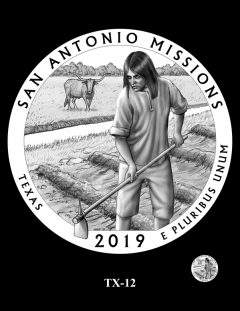 |
TX-10 depicts two Mexican spotted owls perched on ruins in front of Mission Concepción.
TX-11 and TX-11A are symbolic representations of the missions and their proximity to the San Antonio River as a life-giving and community-building water source. TX-11A is a focused version with an off center bell tower element.
TX-12 depicts the elements of farming, ranching and the acequias taught by the missions.
Frank Church River of No Return Wilderness (Idaho)
Twenty-one designs for the Idaho quarter were reviewed.
CCAC Recommendations: Members selected design #5a, but suggested some tweaks to the wolf’s neck.
CFA Recommendations: Members liked design #4, which was also preferred by the site’s liaison.
Due to character limitations on the template the liaison requested that River of No Return go on the template and that the word "Wilderness" be included on at least one of the designs submitted.
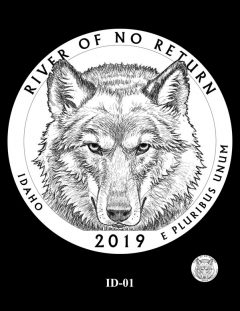 |
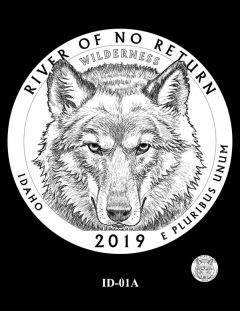 |
ID-01 and ID-01A portray a wolf. ID-01A has the additional text of "Wilderness."
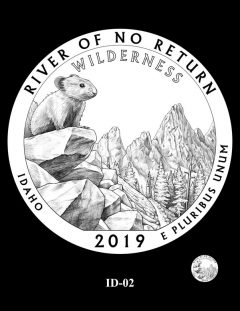 |
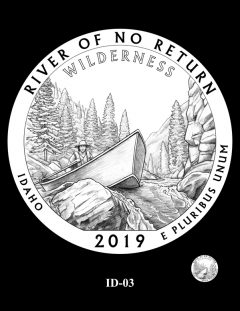 |
ID-02 features a pika in the foreground, with a hiking trail carving a path around the rocky mountain slope. In the distance the distinctive peaks of Fishfin ridge form the backdrop.
ID-03 portrays a drift boat, its pilot, and the rapids of a rocky river with high slopes and conifer trees in the background.
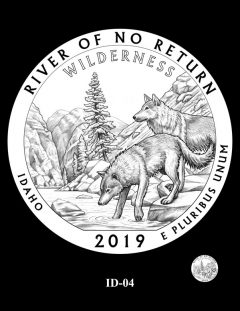 |
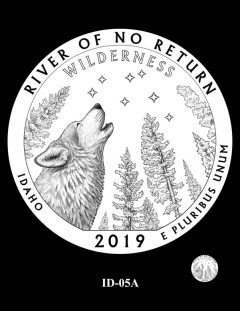 |
ID-04 features a pair of wolves preparing to cross a river. Behind them trees grips the rocky slope, and steep cliffs meet the river’s edge. The park’s liaison and the CFA preferred this design.
ID-05A depicts a scene found far from human habitation focusing on tall conifers and a wolf against a star-filled sky, evoking a sense of remoteness. The CCAC preferred this design.
ID-06 showcases the vast scale of the wilderness as witnessed from the air: mountain peaks and the Middle Fork Salmon River Canyon wending its way to a confluence with the North Fork of the Salmon River. The inscription "WILDERNESS" utilizes the same lettering incised on wooden signposts inside the Frank Church.
ID-07 presents the vantage point of a hiker or boat party in the mighty Salmon River Canyon with its steep and rocky canyon walls and deep waterways. The inscription "WILDERNESS" is based on the lettering found on wooden signposts in the area.
ID-08 and ID-08A depicts recreational pursuits enjoyed in the expansive wilderness. 08 shows a lone rafter, while 08A features a pack string.
ID-09A features a howling wolf.
ID-10 centrally depicts a Grey Wolf regarding the wilderness.
ID-11 features two Grey Wolves gazing upon the wilderness.
ID-12 shows a Grey Wolf observing the wilderness from a high vantage point while rafters ride the river.
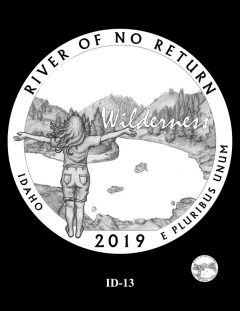 |
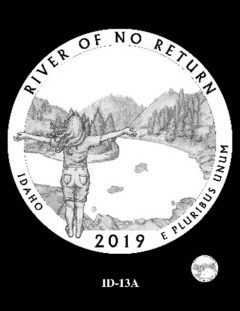 |
ID-13 and ID-13A depict a woman reveling in the beauty of the Middle Fork’s landscape while others enjoy the river from boats. ID-13 features the additional inscription "Wilderness."
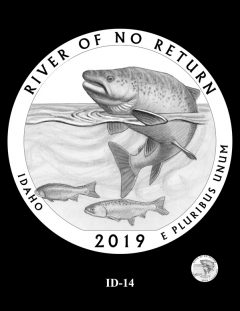 |
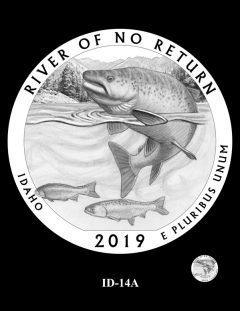 |
ID-14 and ID-14A depict a salmon in the river. 14A additionally shows landscape viewable from the river.
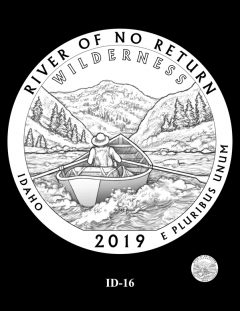 |
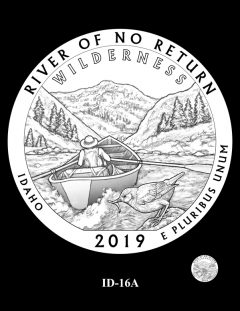 |
ID-16 and ID-16A depict a wooden dory traversing the river with canyon walls, treed slopes and mountains surrounding. 16A features a dipper bird in the foreground.
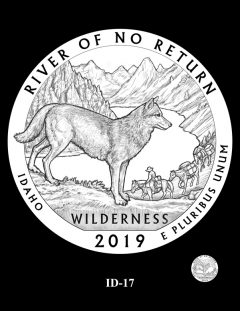 |
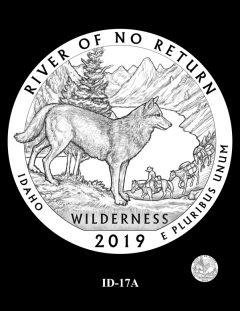 |
ID-17 and ID-17A feature a wolf in the wilderness, standing on a rock overlooking a river and forests below with mountain slopes receding behind and a pack string passing by. 17A additionally features a large group of trees populating the landscape just behind the wolf
The Treasury Secretary is tasked with selecting final designs after receiving recommendations from the CFA, CCAC, U.S. Mint and national site liaisons.
For information about past releases, visit our news section on quarters.

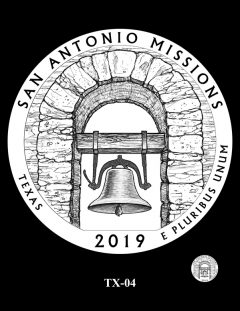
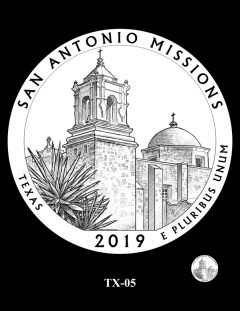
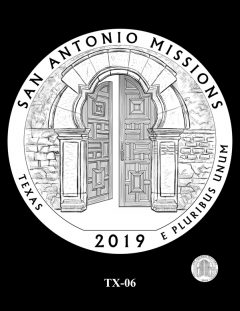
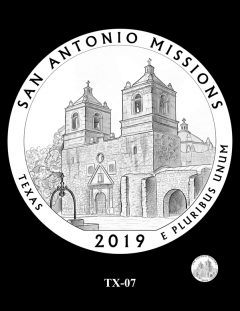
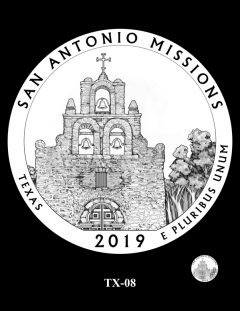
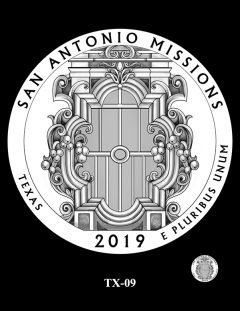
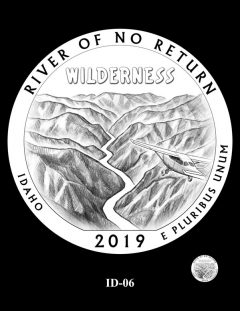
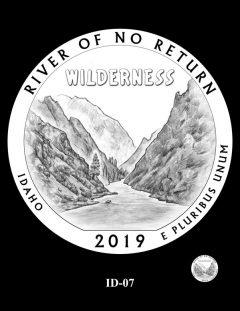
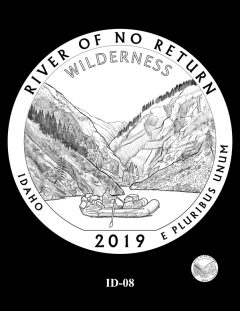
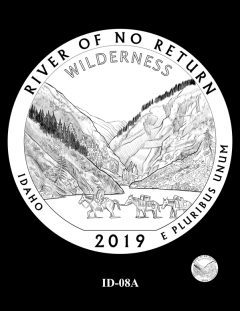
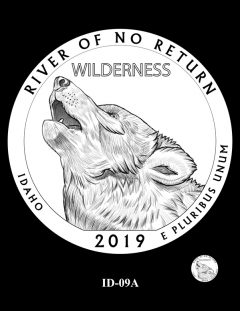
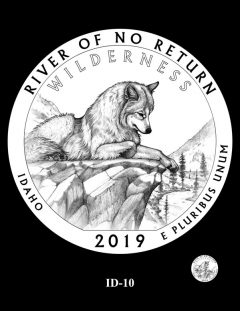
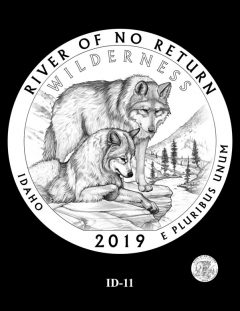
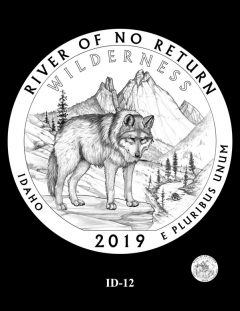
War in the Pacific design candidate GU – 03, one Soldier is on defense on the shore line with his rifle ready, other Soldier sashay’s to shore line. Use your own discretion i would say.
I am sure the families of those who died serving in the War in the Pacific are just thrilled that some PC entries totally ignore the human sacrifices that preserved our way of life (remember it was us who was attacked) by making the theme of this alleged memorial into an endangered turtle or some fish. Those who grew up without fathers and sons b/c of the war likely are the primary ones concerned about remembering the turtles and fish right? When we erase the images of war from life we become sensitized to it – it promotes more war… Read more »